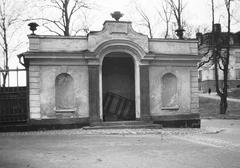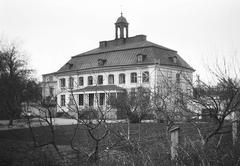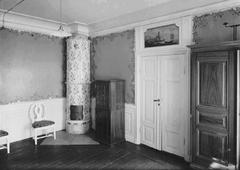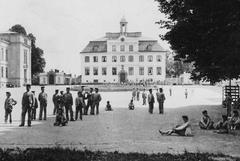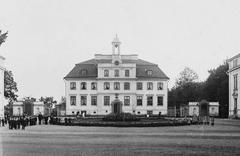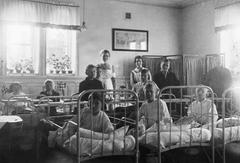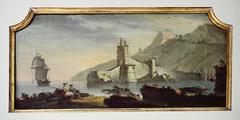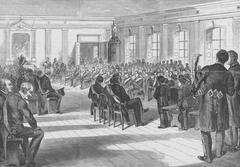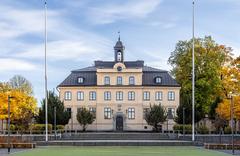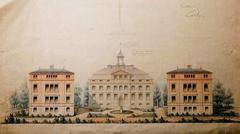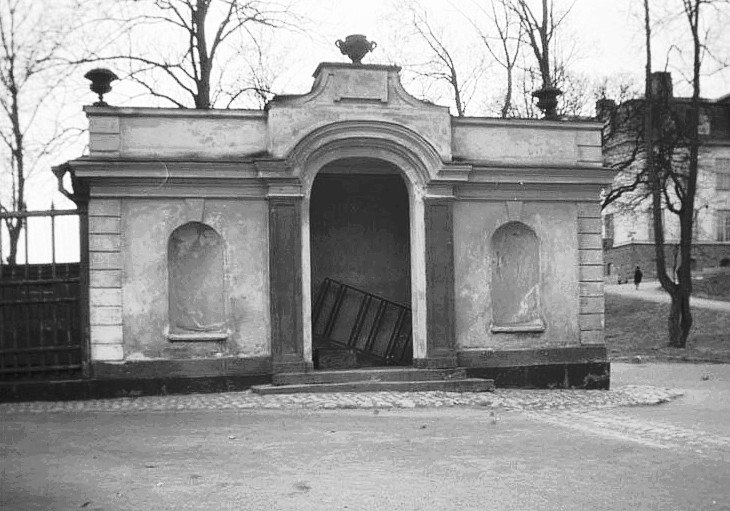
Kristineberg Palace: Visiting Hours, Tickets, and Historic Sights in Stockholm
Date: 14/06/2025
Introduction to Kristineberg Palace
Kristineberg Palace (Kristinebergs slott) stands as a testament to Stockholm’s layered history and Sweden’s evolving architectural and cultural landscape. Tucked into the Kungsholmen district, this 18th-century estate—commissioned by prominent merchant Roland Schröder and named for his wife, Christina—showcases Swedish Rococo design, neoclassical updates, and centuries of social transformation. While less celebrated than the capital’s royal palaces, Kristineberg offers a tranquil escape into the city’s aristocratic roots, complemented by picturesque gardens and vibrant community spaces. Visitors can enjoy the palace’s grand exterior, stroll through historic avenues, and experience the lively atmosphere of the adjacent Kristinebergs Slottspark.
This guide provides comprehensive information on Kristineberg Palace’s visiting hours, admission, accessibility, facilities, and nearby attractions, along with historical insights and practical tips for planning an enriching visit. For further details, consult official tourism and heritage resources (visitstockholm.com; parker.stockholm; nivaland.se).
Table of Contents
- Discovering Kristineberg Palace
- Historical Overview
- Architecture and Artistic Highlights
- Visiting Information
- Kristinebergs Slottspark
- Essential Visitor Tips
- Frequently Asked Questions (FAQ)
- Summary and Recommendations
- References
Discovering Kristineberg Palace
Kristineberg Palace (Kristinebergs slott) offers a unique blend of 18th-century elegance, architectural refinement, and urban green space. Set amid lush parklands on Kungsholmen’s western edge, the palace serves as both a historical landmark and a community hub. While the main building currently houses a primary school and is not open for interior tours, the grounds and gardens are freely accessible, providing a serene retreat within Stockholm’s lively cityscape.
Historical Overview
Origins and Site Development
Built between 1750 and 1754, Kristineberg Palace was the vision of Roland Schröder, whose wealth and ambitions were embodied in the estate’s grandeur. The property was strategically positioned to overlook Lake Mälaren, and its Rococo features—symmetrical wings, ornate stucco, and a mansard roof—reflect the tastes of Sweden’s Age of Liberty. The palace was complemented by formal gardens and avenues, inspired by French and English landscape traditions.
Transformations Over the Centuries
Through the 18th and 19th centuries, the estate passed through aristocratic hands and was periodically expanded with neoclassical elements. Its gardens evolved from rigid, geometric layouts to more naturalistic English landscapes, echoing broader European trends. Kristineberg became a hub for Stockholm’s social elite, hosting cultural salons, musical performances, and grand festivities.
Urban Integration
With Stockholm’s westward expansion in the late 19th century, the city acquired Kristineberg Palace in 1864. The estate’s grounds were gradually opened to the public, while the palace itself adapted to new uses—including housing educational institutions. Today, Kristineberg’s integration into urban life is a model of heritage preservation and community engagement.
Architecture and Artistic Highlights
Kristineberg Palace exemplifies Swedish Rococo architecture, characterized by harmonious proportions, decorative plasterwork, and a stately façade. Neoclassical modifications in the early 19th century, such as the chapel, lend an added layer of elegance. Though the interiors are not open to the public, visitors can admire the palace’s exterior and the carefully restored garden features, which include tree-lined avenues, lawns, and remnants of historic designs.
(Pineqone)
Visiting Information
Opening Hours
- Palace Grounds: Open daily from dawn until dusk.
- Palace Interior: Not open to the public, as the building functions as a primary school (Kristinebergsskolan).
Admission and Tickets
- Admission: Free; no tickets are required for the park or palace exterior.
- Guided Tours: No regular public tours of the interior. Occasional guided walks of the grounds may be organized by local associations.
Accessibility
- Grounds: Mostly flat and accessible, with paved and gravel paths suitable for wheelchairs and strollers.
- Facilities: Benches, picnic areas, and accessible playgrounds are available in the park. Restrooms are located near Uggleparken playground.
Directions
- By Metro: Green line to Kristineberg station, then a 5-minute walk.
- By Bus or Bike: Well-connected via city routes and cycling paths.
- Parking: Limited street parking nearby; public transport is strongly recommended.
Facilities
- Food and Drink: Cafés and restaurants within a short walk, especially around Kristineberg and Fridhemsplan.
- Restrooms: Available in the park and at nearby shopping centers.
- Accessibility: Ramps and paved paths throughout the park.
Nearby Attractions
- Stockholm City Hall: Iconic venue for the Nobel Prize banquet, a 15-minute walk away.
- Rålambshov Park: Popular urban green space for recreation and events.
- Karlberg Palace: Another historic estate, accessible via Kungsholmen’s walking and cycling paths.
- Västermalmsgallerian: Shopping and dining center.
- Smedsuddsbadet: City beach on Lake Mälaren.
Kristinebergs Slottspark
Historic Evolution and Landscape
Kristinebergs Slottspark, adjacent to the palace, is a landscape shaped by centuries of history and urban development. Its origins date back to the 17th century, with lime tree avenues, orchards, and open lawns that remain today. The park has undergone thoughtful renovations to enhance accessibility, sustainability, and community use.
(parker.stockholm; nivaland.se)
Uggleparken Playground
A highlight for families, Uggleparken (the Owl Park) is a beloved, secure playground known for its whimsical wooden sculptures—including two giant owls—spinning mushrooms, and accessible play structures. The playground is fully enclosed, features a café and restrooms, and is open year-round at no charge.
(barnistan.se; visitstockholm.se)
Äppelparken and Recreation
Äppelparken, with its rows of fruit trees, offers an idyllic setting for picnics and relaxation. The park’s open lawns, ancient oaks, and flower beds make it a green oasis for all ages.
Community Life and Events
Kristinebergs Slottspark is a living part of the neighborhood, hosting community gatherings, outdoor concerts, and seasonal festivals. The adjacent Kristinebergs Idrottsplats supports local sports, while the park’s layout encourages walking, jogging, and cycling. Special events and temporary art exhibitions are occasionally organized by local groups.
(bonava.se; verdeverdetravel.nu)
Essential Visitor Tips
- Best Seasons: Spring and early summer for blooming trees; autumn for colorful foliage.
- Photography: The palace and park offer excellent photo opportunities, especially during golden hour. Avoid photographing school activities or children.
- Family Visits: Uggleparken and open lawns are ideal for children. Dogs are welcome on leashes in park areas.
- Events: Check community listings or the official park page for updates on special events.
- Etiquette: Respect school activities and restricted areas. The palace interior is not open to the public.
Frequently Asked Questions (FAQ)
Q: What are Kristineberg Palace visiting hours?
A: The palace grounds are open daily from dawn until dusk. The interior is not accessible to the public.
Q: Is there an entrance fee?
A: No, visiting the park and palace exterior is free.
Q: How do I get to Kristineberg Palace?
A: Take the green metro line to Kristineberg station, then walk five minutes to the palace.
Q: Are guided tours available?
A: The interior is not open for tours. Occasional guided walks of the grounds may take place—check local listings.
Q: Is the park accessible for people with disabilities?
A: Yes, most paths are paved and suitable for wheelchairs and strollers.
Q: Are dogs allowed?
A: Yes, on leashes in the park but not in school areas.
Q: What facilities are available?
A: Playgrounds, picnic areas, benches, restrooms, and nearby cafés.
Summary and Visitor Recommendations
Kristineberg Palace and Kristinebergs Slottspark offer a harmonious blend of history, architecture, and vibrant community life. Visitors can enjoy the palace’s refined Rococo and neoclassical style, stroll historic avenues, and relax in green spaces that foster inclusivity and sustainability. While the palace interior is closed due to its school function, the accessible grounds, family-friendly amenities, and proximity to other Stockholm attractions make Kristineberg a rewarding stop for history buffs, families, and casual explorers alike.
For the latest updates on visiting hours, special events, and guided activities, consult official tourism resources or consider downloading the Audiala app for immersive self-guided tours and local insights. Exploring Kristineberg Palace and its park means engaging in a living narrative of Swedish heritage and urban vitality.
(visitstockholm.com; parker.stockholm; nivaland.se)
References
- Kristineberg Palace on Visit Stockholm
- Kristinebergs Slottspark Official Site - Parker Stockholm
- Kristineberg Palace Project Overview - Nivaland
- Kristineberg Palace Guide - Pineqone
- Kristineberg Palace on Wikipedia
